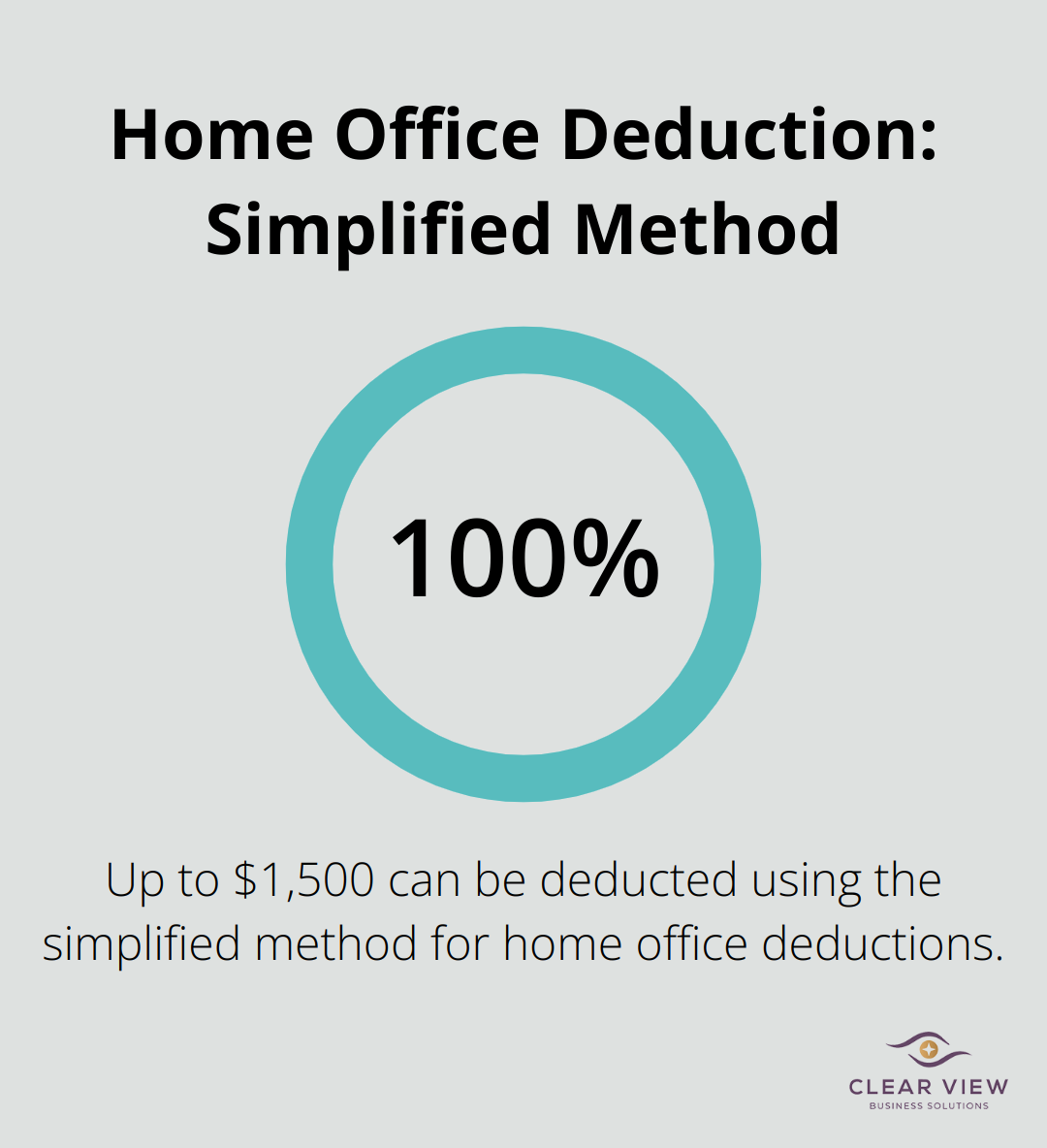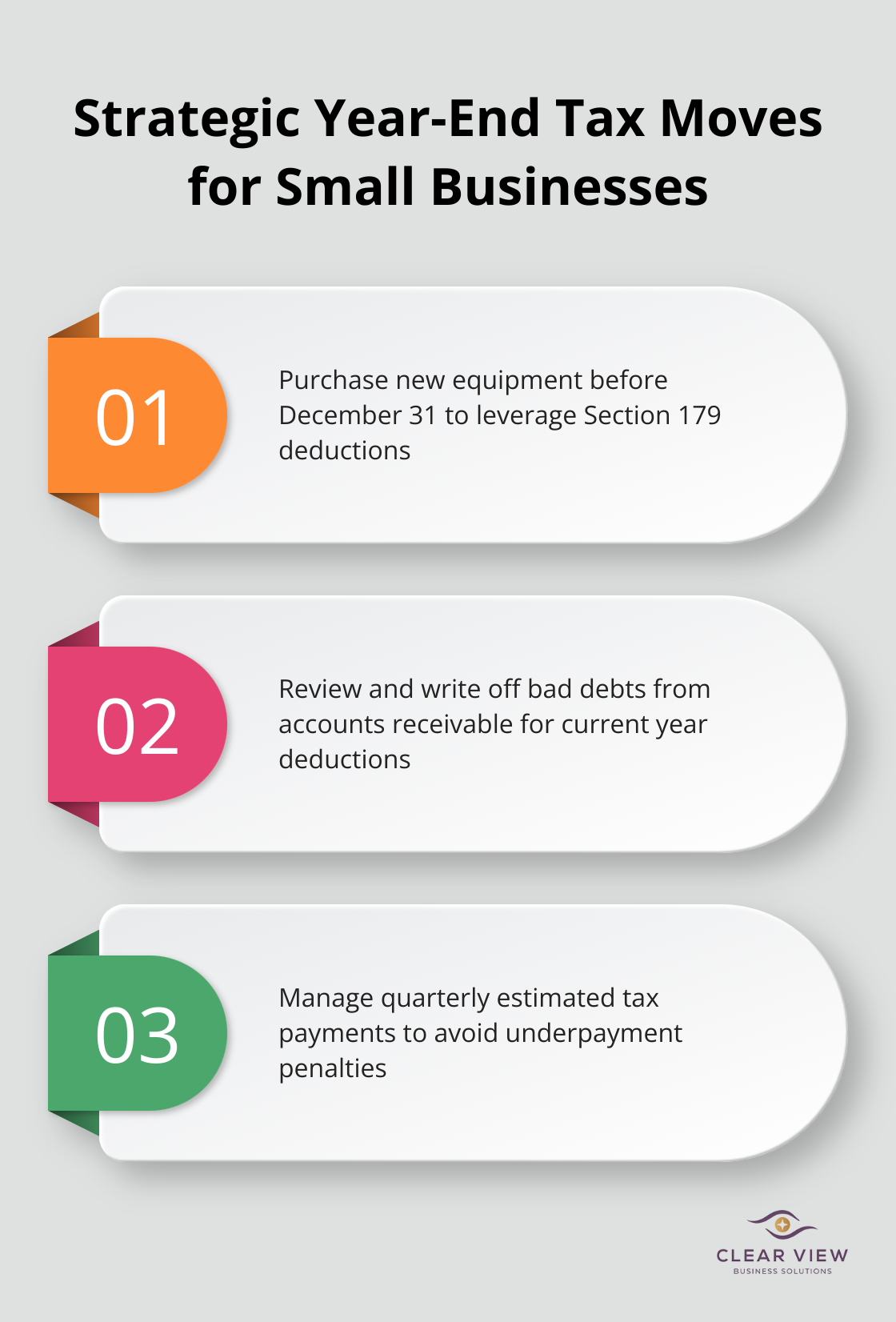

Tax planning for small businesses can make or break your financial success. At Clear View Business Solutions, we’ve seen firsthand how proper tax strategies save companies thousands of dollars each year.
This guide will walk you through the key considerations for small business tax planning, from choosing the right business structure to maximizing deductions and timing your financial moves strategically.
A sole proprietorship offers the simplest business structure. It provides complete control over your business but exposes you to personal liability for all business debts and legal issues. For taxes, you report business income on your personal tax return using Schedule C. This simplifies filing but can result in higher self-employment taxes.
Partnerships allow multiple owners to share profits and management responsibilities. Two main types exist: general partnerships (all partners share equal liability) and limited partnerships (some partners have limited liability and involvement). Partnerships file an informational return, but profits and losses pass through to the partners’ individual tax returns. This structure can offer tax efficiency but requires careful planning to avoid disputes over profit distribution and tax responsibilities.
Limited Liability Companies (LLCs) provide certain tax benefits and greater flexibility, and they also come with a lot less paperwork than C corporations and S corporations. LLCs can be taxed as sole proprietorships, partnerships, or corporations (depending on the number of members and their preferences). This flexibility allows for strategic tax planning. For example, a single-member LLC can avoid double taxation while still enjoying liability protection.
S Corporations can help you avoid higher self-employment taxes by classifying some income as salary and some as a distribution. Profits and losses pass through to shareholders’ personal tax returns, potentially reducing self-employment taxes. However, S Corps must meet strict eligibility requirements and follow specific operational rules. They benefit businesses with significant income, as owners can pay themselves a reasonable salary and take additional profits as distributions (which aren’t subject to self-employment tax).
C Corporations typically serve larger businesses or those planning to go public. They provide the strongest liability protection and the ability to raise capital through stock sales. However, C Corps face double taxation – once at the corporate level and again when dividends reach shareholders. Despite this drawback, C Corps can advantage businesses reinvesting profits or those in high-tax brackets, as corporate tax rates may fall below individual rates.
Selecting the right tax structure for your business requires careful consideration of your specific circumstances and goals. The next section will explore effective tax deductions that can help small businesses maximize their financial efficiency, regardless of their chosen structure.

Small businesses have numerous opportunities to reduce their tax burden through strategic deductions. Let’s explore some key areas where your business can potentially save money.
If you use a portion of your home exclusively for business, you may qualify for a home office deduction. The IRS allows you to deduct $5 per square foot of your home office space, up to 300 square feet. This simplified method can result in a deduction of up to $1,500. Alternatively, you can calculate the actual expenses related to your home office, including mortgage interest, property taxes, utilities, and maintenance.

Business-related vehicle use presents a significant deduction opportunity. You can either deduct actual expenses or use the standard mileage rate (65.5 cents per mile for 2023). Keep detailed logs of your business trips, including dates, destinations, and purposes.
For travel expenses, you can deduct 100% of transportation costs and lodging. Meal expenses are generally 50% deductible, but exceptions exist. For instance, meals provided to employees for the employer’s convenience are 100% deductible through 2025.
Depreciation allows you to deduct the cost of business assets over time. Section 179 of the tax code permits businesses to deduct up to $1,220,000 for qualifying equipment and software purchased or financed during the tax year beginning in 2024.
Bonus depreciation serves as another powerful tool. For certain qualified property acquired after September 27, 2017, and placed in service after December 31, 2023, 60% bonus depreciation is available.
Offering employee benefits not only attracts talent but also provides tax advantages. Health insurance premiums, life insurance coverage, and education assistance programs are typically tax-deductible for the business and tax-free for employees.
Setting up a retirement plan like a SEP IRA or a 401(k) can yield significant tax benefits. Contributions to these plans are generally tax-deductible for the business, and they grow tax-deferred until withdrawal.
Small business owners should consider consulting with a reputable tax advisory service to develop a comprehensive tax strategy. Expert knowledge of local and federal tax laws can help you navigate these deductions effectively, ensuring you don’t leave money on the table while staying compliant with IRS regulations.
The next crucial step in small business tax planning involves understanding the importance of timing in your financial decisions. Let’s explore how strategic timing can further optimize your tax situation.
Tax planning requires strategic timing. You can impact your small business’s tax liability significantly through careful management of income and expenses. If you expect a lower tax bracket next year, defer income to the following year. This might involve delaying billing for services or postponing asset sales that would result in capital gains.
If you anticipate a higher tax bracket next year, accelerate income into the current year. Consider offering discounts for early payment or complete more billable work before year-end.
For expenses, if you use cash-basis accounting, prepay some expenses to increase deductions in the current year. This could include paying January’s rent in December or purchasing office supplies in bulk.
The end of the year presents unique tax planning opportunities. If you plan to purchase new equipment, do so before December 31 to take advantage of Section 179 deductions or bonus depreciation in the current tax year. For 2025, businesses can deduct up to $1,250,000 in qualifying purchases.
Review your accounts receivable before year-end. Write off any bad debts unlikely to be collected. This can provide a deduction in the current year.

Many small business owners must manage quarterly estimated tax payments. The IRS requires these payments if you expect to owe $1,000 or more when you file your return. Failure to make these payments can result in penalties.
To avoid underpayment penalties, you generally need to pay either 90% of your current year’s tax liability or 100% of your previous year’s tax (110% if your adjusted gross income exceeded $150,000).
Tax timing strategies can be powerful, but they require careful implementation in compliance with tax laws. Consult with a tax professional before making significant changes to your tax strategy. Clear View Business Solutions can provide personalized advice tailored to your specific business situation, helping you navigate these complex decisions with confidence.
While short-term tax savings are important, don’t lose sight of your long-term business goals. Some tax strategies might provide immediate benefits but could impact your future financial position. Try to balance immediate tax savings with your overall business strategy.
Consider how your tax planning decisions align with your business growth plans, investment strategies, and potential exit strategies. A holistic approach to tax planning (considering both short-term and long-term implications) will serve your business best in the long run.
Tax planning for small businesses requires a strategic approach to reduce tax burdens and improve profitability. Choosing the right structure, maximizing deductions, and timing financial decisions can lead to significant savings. Professional guidance proves invaluable in navigating the complex world of small business taxes, as laws constantly evolve.
Clear View Business Solutions specializes in developing comprehensive tax strategies for small businesses in Tucson. We help businesses comply with current regulations and take advantage of available tax benefits. Our expertise ensures that tax planning becomes a powerful tool for long-term financial success.
Effective tax planning for small businesses goes beyond compliance and supports growth, improves cash flow, and increases profitability. It reduces stress during tax season, helps avoid costly mistakes, and allows more resources for business development. A solid tax strategy can also make a business more attractive to potential investors or buyers in the future.
At Clear View Business Solutions, we know you want your business to prosper without having to worry about whether you are paying more in taxes than you should or whether your business is set up correctly. The problem is it's hard to find a trusted advisor who can translate financial jargon to layman's terms and who can actually help you plan for better results.
We believe it doesn't have to be this way! No business owner should settle for working with a CPA firm that falls short of understanding what you want to achieve and how to help you get there.

Northwest Location:
7530 N. La Cholla Blvd., Tucson, AZ 85741
Central Location:
2929 N Campbell Avenue, Tucson, AZ 85719
© 2025 Clear View Business Solutions. All Rights Reserved.
At Clear View Business Solutions, we know you want your business to prosper without having to worry about whether you are paying more in taxes than you should or whether your business is set up correctly. The problem is it's hard to find a trusted advisor who can translate financial jargon to layman's terms and who can actually help you plan for better results.
We believe it doesn't have to be this way! No business owner should settle for working with a CPA firm that falls short of understanding what you want to achieve and how to help you get there. With over 20 years of experience serving hundreds of business owners like you, our team of experts combines financial expertise and proactive communication with our drive to help each client achieve results and have fun along the way.
Here's how we do it:
Discover: We start with a consultation to understand your specific goals, what's holding you back, and what success looks like for you.
Strategize & Optimize: Together, we design a customized strategy that empowers you to progress toward your goals, and we optimize our communication as partners.
Thrive: You enjoy a clear view of your business and your financial prosperity.
Schedule a consultation today, and take the first step toward being able to focus on your core business again without wondering if your numbers are right- or what they mean to your business.
In the meantime, download, "The Business Owner's Essential Guide to Tax Deductions" and make sure you aren't leaving money on the table.